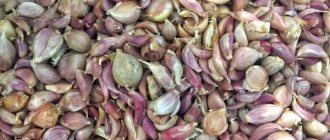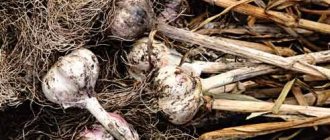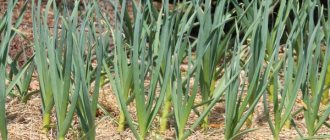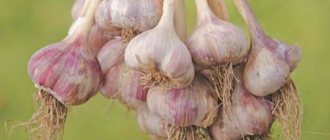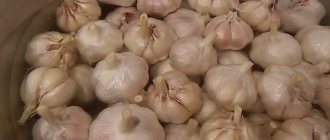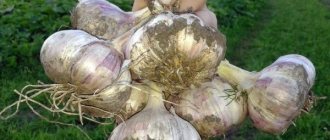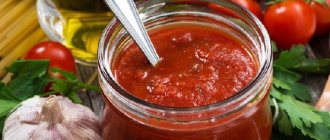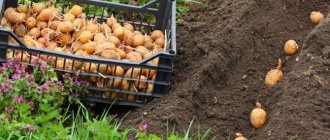Is fertilizer needed?
Garlic is a plant with an underdeveloped root system. It does not take root deep into the soil and is located in its surface layer. For this reason, it is necessary to fertilize the vegetable when planting before winter. This is the only way to get large and juicy heads. If you neglect to fertilize, the plant will not grow well, and its cloves will become small and dry.
Only with focused work can you achieve strong and healthy garlic that does not get sick and produces good fruits year after year. The first step to obtaining such a harvest is preparing the land for garlic beds. It can be started 3-4 weeks before planting.
Important! Garlic should not be planted in waterlogged or acidic soil: it will not tolerate such conditions and will quickly rot.
The soil for the garlic bed should be in an open, dry and well-lit place.
How to properly place garlic in the garden
You should not start planting the crop immediately, but about a week after applying the fertilizer. For garlic in the fall, it is very important to follow the planting rules, since watering at this time of year is very limited and the cloves may not take root well.
The most common way to plant garlic is in beds made with a hoe, but you can do it another way - make a hole for planting each clove. To do this, you need to take a metal tube or peg and push holes to the required depth.
When you use large cloves for planting, the holes should be 7 cm deep, and if the planting material is not too large, then 4–5 cm. Just before planting, pour a little wood ash into the hole - this will provide feeding for your garlic until spring.
Whatever planting method you choose, remember that the rows need to be placed at a distance of at least 25 cm from each other, and the spaces between the cloves should be about 7–10 cm wide in the palm of your hand. Do not press the cloves themselves too much - you can damage the bottom and they will not take root well, it is better to simply “put” them at the required depth and carefully cover them with soil.
Preparing the soil for planting
Along with other vegetables, garlic is included in the crop rotation cycle, which lasts from 4 to 5 years. Its predecessors may be:
- all types of cauliflower;
- all types of salads and greens;
- cucumbers;
- squash.
First, the bed is disinfected by treating it with copper sulfate. To do this, prepare a solution in the ratio of 1 tablespoon per 10 liters of water. After treatment, the soil is dug up. The digging depth should be 20 cm. At the same time, all weeds are removed together with the roots so that they do not drown out the young garlic.
The dug up soil is fertilized with humus or rotted compost, with the addition of superphosphate (20 g) and wood ash (1 cup). The prepared soil is watered abundantly and covered with polyethylene. Thus, the soil will retain its lushness, looseness, oxygen and will be completely ready for planting.
Harvesting
Garlic can be harvested when a couple of lower leaves have turned yellow or dried out. The bulbs are pulled out and, together with the leaves, laid out on beds or hung in bunches in a dry, ventilated room. As the stems dry, the nutrients from them move into the bulb. Garlic is considered ready for storage when it begins to rustle in your hands. It is tied into braids or, after cutting off dry foliage, placed in linen bags for subsequent storage.
The best fertilizers in spring and autumn
Fertilizers applied to garlic in the fall are:
- organic (wood ash, manure);
- green manure;
- mineral (complex).
The benefits of ash and manure
Manure is good as a top dressing, but it is better not to use it in the autumn. The garlic fruits will become loose, and the plant itself will be vulnerable to dangerous fungal spores. Due to manure, the growth of the vegetable will go into the green tops, and the heads will grow small.
Advice!
Manure is a good fertilizer for garlic in spring. It is diluted 1:6 and the beds are fertilized in the vegetative phase 2 to 3 times.
Wood ash is the best organic material for any vegetable. Garlic beds are fertilized with it, adding it with humus and digging up the soil. You can plant a vegetable and apply wood ash into the furrows in the beds. Two weeks after planting the plant, it is watered with an ash solution. The solution is prepared as follows: take a tablespoon of ash and dissolve it in a liter of water. 2-3 liters of solution is enough for 1 m2.
Chemical (mineral) fertilizers
Mineral fertilizers can also be applied in the fall under garlic. Before planting, the soil is fertilized with superphosphates and potassium. Superphosphate nourishes the plants, and potassium forms the root system before the onset of winter cold. When applying mineral fertilizers, you need to ensure that they contain less nitrogen. Nitrogen promotes green growth. This can harm winter garlic, as the greens will soon freeze. Nitrogen-containing compounds are added to the soil in the spring.
Superphosphates contain a minimal amount of nitrogen - only 8%. It is well suited for fertilizing the soil for vegetables in the fall. In superphosphates, the amount of nitrogen is better balanced with other substances. This ensures the correct balance between the root and above-ground parts of the plants.
There are several complex mixtures that are designed specifically for garlic. If you fertilize garlic beds with them, the plants will not put out green arrows before frost. In addition to superphosphate, you can use the following compositions:
- phosphorus flour;
- potassium salts;
- “winter” azophoska;
- nitroammophoska;
- two-component fertilizers.
All these substances help strengthen the root system of winter garlic and its proper growth. They are applied along with other fertilizers - ash and other organic matter.
Planting green manure
The soil for vegetables in the fall can be fertilized with green manure plants. Garlic gives a good reaction to any organic compounds and “predecessor” cultures. For this reason, gardeners often use green manure.
Attention!
The land for green manure must be cleared of other plants by the end of July.
The following are used as green manure:
- all legumes (including beans and peas);
- cereals (barley and rye);
- phacelia;
- mustard.
One of the best green manures is considered to be the white variety of mustard. All these crops prevent snow from penetrating into the soil. Thanks to them, winter garlic can withstand low air temperatures. Green manure also contains essential oils and phytoncides. They destroy harmful insects and parasitic fungi.
Green manure should be mowed from the garden a couple of weeks before planting garlic. The bed needs to be dug up and all the greenery planted in the ground. The embedding depth is from 15 to 20 cm.
Foliar feeding
A good harvest can be obtained by using foliar feeding techniques. Fertilizers are not applied under the roots of garlic, but sprayed above them. When the garlic feathers begin to turn yellow, the best time comes to apply foliar feeding:
- urea;
- ammonium nitrate.
In this case, a weakly concentrated solution is used so as not to harm the plant.
Important!
You can feed garlic foliar only in the evening. Feeding on a dry, sunny day can completely burn the feathers.
Basic rules for applying root fertilizers
Despite the fact that fertilizers can differ dramatically in both composition and concentration of substances, there are general points, observing which minimizes the possibility of harming young, immature shoots.
- Liquid nutrition is applied at the root, avoiding contact with the stem and leaves, which may cause burns. It is convenient to fertilize with solutions from a watering can with a narrow spout.
- Nutrients in dry form are carefully distributed between the rows of the bed, also trying not to get on the above-ground part of the plant. After this, the plantings need to be watered abundantly.
- Applying liquid fertilizers at the root does not require preliminary watering of the soil, since garlic does not like excessive soil moisture.
- Working solutions must be at ambient temperature. Liquids that are too hot or cold can cause plants to go into shock.
- Solutions cannot be used later than 24 hours after preparation. This is due to the fact that under the influence of temperature, ultraviolet radiation and oxygen, chemical transformations of substances can occur in them.
- Experienced gardeners do not recommend giving preference only to mineral substances, or, on the contrary, only to organic fertilizers. It is optimal for plants to alternate these two types of nutrition.
We recommend reading
Technology for growing garlic in open ground, care
When and how to plant garlic in the fall before winter
Schemes and timing of planting garlic bulbs before winter
After what predecessors is it best to plant garlic before winter?
How to fertilize garlic to make it grow large
The main organic fertilizer that promotes the growth of large fruits is wood ash. You can also apply manure under the winter garlic, but not fresh, but rotted manure. For 1 m2, 5 to 6 kg of manure will be enough. A mixture of manure and peat will need more, from 8 to 10 kg. Compost from other organic substances is applied to the beds in an amount of 8 to 10 kg per 1 m2.
Determination of soil acidity
The best choice for garlic would be neutral or slightly acidic soil . When analyzing soil acidity, the pH should be above the neutral value of 6.5. An indicator of acidity is the weeds growing on the soil chosen for planting.
Read also: Control of MTZ 1221 hitch
The presence of plantain, mint, and buttercup indicates that the soil acidity is increased. If the soil is neutral or slightly acidic, nettles, cornflowers, clover, and chamomile grow on it.
There are ways to determine soil acidity:
- Soil meter. Using a special device, you can accurately determine the condition of the soil.
- Vinegar. If you pour vinegar on a handful of soil, bubbles should appear on its surface. If this does not happen, then the acidity is increased.
- Currant, cherry or bird cherry leaves. The leaves of any of these plants are poured with boiling water, wait for the water to cool, and add soil to it. If the color of the water changes to red, it means that the acidity is increased. If it turns green, the soil is neutral. If the water turns blue, this indicates that the soil is slightly acidic.
When the soil is highly acidic , plants are unable to absorb nutrients. Garlic roots practically do not develop in acidic soils.
Fertilizer consumption rates for different types of soils
If you have a plot of land with depleted soil, you cannot do without fertilizers. When applying them, the original structure of the soil and its acidity level are taken into account. Working to improve the soil composition will help grow a good harvest and improve the exchange of air between the garlic root system and the external environment. Heavy soils with a high clay content are fertilized with sand - up to 10 liters per 1 m2. If the soil is sandy or sandy loam, it needs peat and fine clay, in a ratio of 10:10 per 1 m2. Swampy soil is enriched with sand and loam (10:10 per 1m2).
Deadlines
The garlic fertilizing schedule during the growing season - regardless of whether winter or spring varieties are grown - includes 3-time application of fertilizers.
- At the beginning of spring: winter garlic is fed as soon as the snow melts, spring garlic - when the first 2-3 leaves appear;
- 2 weeks after the first feeding.
- At the beginning of the period of clove formation and head formation: winter garlic - in mid-June, spring garlic - at the end of June.
Attention! Untimely fertilization can cause early bolting of garlic and abundant growth of greenery to the detriment of the heads.
Reviews
Vasily (Ryazan region)
“I grow winter garlic on the plot. Usually the harvest was small. The heads grew strong, but small. A neighbor advised us to fertilize the soil with wood ash. The result turned out great: the garlic grew large and juicy, without turning into a green mass. I was very pleased with the result; now I fertilize garlic with ash every year.”
Rita (Perm)
“I decided to conduct an experiment when growing winter garlic and planted mustard in the garden. I read on a gardeners forum that mustard is one of the best green manures. Everything has been confirmed in practice. I planted mustard, then dug up the bed. Garlic not only survived the winter, but also pleased us with its large fruits and excellent taste.”
When growing winter garlic, you not only need to remove weeds and water the plant, but also apply fertilizer. This work will certainly pay off: you will get a large harvest of garlic with excellent taste.
